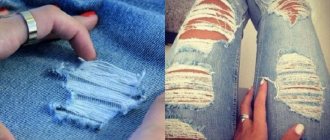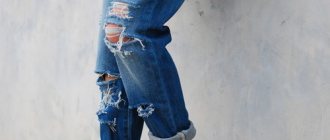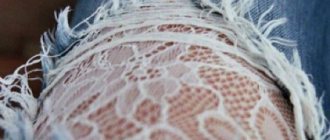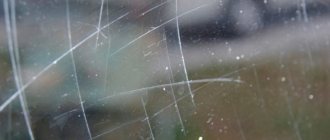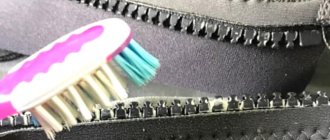09/15/2019 Maria Ivanova 0 comments
Distressed jeans with an antique effect, slightly faded, with a beautiful texture are the desire of every fashionista (and fashionista too). Today, distressed, washed-out jeans are in fashion! Perhaps, such a passion for denim existed in the nineties. And now it’s back and gaining momentum! How to make scuffs on jeans with your own hands? Let's find out!
But not everyone can buy fashionable, worn trousers in a store; the prices for more or less beautiful models are very high, and what is cheap often does not look the way one would like. So why overpay? Moreover, there has been a pair of practically new jeans lying around in my wardrobe since last season. It's time to find out how to make beautiful and stylish scuffs and create a fashionable look with your own hands!
Which jeans are suitable?
Do not rush to attack clothes with piercing and cutting instruments and improvised means. First, let's determine which pants are suitable for this and what preparatory procedures are needed. You don’t want the result to disappoint you and your time to be wasted, do you? So let's get started.
- Jeans should not be too tight, but not too thin. Ideally, classic denim, simple jeans that we wear all year round.
- They should not be stretch, as knitted fabric is difficult to process and the effect will not be the same.
- Let the thing be old - it doesn’t matter. The main thing is that it is clean, dry and ironed. You can make abrasions on smooth and clean fabric, so prepare the item in advance.
- Color does not matter. These can be either classic “varenki” or bright monochromatic models: red, green, red. It will also look good on white and very light colors, as well as on black.
- The style is at your discretion. Scuffs look great on narrow models, “pipes”, fashionable “pipes” and wide cropped pants. All options are good!
So, everything is ready, the jeans are prepared and awaiting their fate. Let's get to work, or rather, start the creative process!
Sequence of wiping jeans at home
Before you start aging jeans with your own hands, especially for the first time, it is recommended to practice on a small piece of similar material to understand the basic principle of operation.
For any fabric density, the decorating process can be divided into the following stages:
- First, you need to decide on the right model, based on the desired end result. It should be borne in mind that not all jeans will be able to achieve a worn effect; dark-colored models are least suitable for these purposes.
- It is necessary to mark areas of future changes with chalk or soap
- Organize a spacious workplace, giving preference to flat surfaces
- One of the main stages is the choice of tools; the final result will largely depend on this
- Next comes the process of rubbing and decorating, depending on what the result should be at the end of the work, you should allocate a sufficient amount of time for it, and most importantly, do not act in a hurry, then the altered jeans will look beautiful and, at the same time, carefully.
- After the desired effect is achieved, the jeans should be washed; it is worth considering that after washing, the abrasions will become brighter, and the cuts may slightly change their shape.
TIP: You should not age jeans in the seam area; after regular wear and several washes, there is a high probability that the fabric will begin to unravel.
How to make rips on jeans
Photo: https://pixabay.com/photos/jeans-tape-measure-fabric-scissors-2406521/ To make scuffs on jeans, craftsmen have invented several methods.
For these purposes, only available means are used, and the result in each case will be excellent. Let's tell you more about each technology. Before you begin, take a piece of chalk or a bar of soap and mark on your clothing exactly where the worn areas will be.
Don’t overdo it: this is a stylish accent, a piquant detail, and if there are a lot of them, it will look ugly and vulgar. Mark asymmetrical areas on each leg or just one and then get to work.
Using a grater
The same one that is in your kitchen. Or rather, its smallest side. We don't like to use it in cooking because it's a lot of hassle. But for fashionable design purposes, this tool is just what you need!
Take a fine grater and begin vigorously rubbing the targeted area. You can partially cut off the threads that come out, and partially pull them out: it should look chaotic and natural. Do not get carried away so as not to make a through hole. Although, if there is a small hole, it will be even more interesting.
Fray the edges by hand, pull out some threads at your discretion. Adjust the size of the rubbed spot by pressing the grater. Ready!
Using pumice
Yes, yes, the one that makes our heels always soft, smooth and pink. An irreplaceable thing, because with its help you can create a beautiful soft abrasion with a “gradient” effect, that is, there will be no hard transition to the hole, and the fabric seems to have worn out by itself over time.
The essence is the same: using pumice, rub a fragment that has been previously selected and marked with soap or chalk. Pumice works softer than a grater, from it the threads gradually become thinner, and a bleached spot of frayed thin fabric appears. Looks very nice!
Additionally, pumice can be used to finish the edge of a scuff when you are doing it with a float. Once your area is wiped down and ready, run a pumice stone around the edge to level it out. It will be neat and very impressive!
Using a hook
Photo: https://pixabay.com/photos/crochet-crochet-hook-hobby-close-up-1153219/
You can use a crochet hook to make beautiful holes and scuffs, with the ability to work a section of fabric more finely. It’s better to first rub the area a little with a grater to make the threads thinner. Then you need to cut and pull out the horizontal threads, and leave the vertical ones intact. This will leave a thin “web” of threads, a beautiful mesh.
You should not do this evenly: in some places you can leave missing horizontal threads, and cut off some vertical ones. It should look chaotic and lively. The edge should be treated with pumice, and let it not be smooth, but slightly torn.
With the help of "Whiteness"
With the help of “Whiteness” you can make abrasion in a faded area, this will look even more stylish. But in no case should you pour white directly onto the thing: this will result in an ugly, clear stain.
Wear rubber gloves and be careful when working: this is an aggressive product and should not be splashed so as not to get on your skin or eyes.
Apply a little bleach to a cotton swab and lightly blot a piece of fabric. Rinse immediately with water and see what happens. If necessary, repeat the procedure to enhance the whitening.
Then lightly rub the fabric in this area with a grater or pumice stone. Please note: whiteness not only lightens the fabric, it also makes the threads thinner and more brittle, so that fraying remains easy and will become more obvious over time.
Blade
The blade can make beautiful, neat holes, but also abrasions.
Take a pant leg and slide a piece of plywood, very thick cardboard, or a piece of wood inside to avoid damaging the back of the jeans. Gently scratch the fabric with the blade, but do not press too hard: only tear individual threads. If you press too hard, you'll end up with a flat, unsightly cut. With such light movements, cut several vertical threads, and pull out some by hand or crochet. Walk over the top with pumice and you're done!
Now the main trick. After the procedure, put the jeans in the washing machine and wash them on a fast cycle, but at high speed. Let the machine give them a good beating! Thanks to this, the new wear will become natural, the threads will soften, and the overall appearance will be very beautiful and natural. Dry the item and put on your stylish new thing!
Why is it necessary?
Having jeans with holes and fringes means being stylish and on trend. You can buy a ready-made model, aged at the time of manufacture according to the designer’s sketches. It is much more practical to make holes, scuffs, and fringes with your own hands. You will have to spend a little time, but the item will be 100% unique.
Sometimes jeans are worn and torn forcibly, the reasons that force this to happen:
- the item faded after washing;
- my pants got caught on a sharp object, a hole appeared in a visible place;
- hair dye got on the fabric;
- your foot touched an enamel-painted bench;
- Stains from grass, blood, and fat cannot be removed from the trouser leg.
You can list for a long time the reasons why good pants lie in the closet. Using the methods described below, it is easy to revive a damaged item and make a new one more stylish.
Tool: scissors
Perhaps this method can be called the most common and most beloved among fashionistas with a passion for handmade. Start with small horizontal strips, which, after you cut them out, should be “gutted” using the same scissors or a regular fork. Use tweezers to pull out the threads that will turn into fashionable fringe. A useful life hack: in denim, the white threads run horizontally and the blue threads run vertically (by removing the blue threads, you can create a white “thread” on the jeans).
Ways to transform jeans
There are three ways to achieve the desired result:
- mechanical - involves exposing the fabric to abrasive means: friction with sandpaper, pumice, or a piece of red brick;
- chemical - based on bleaching fabric with products containing chlorine;
- thermal - is a long-term boiling of trousers with bleaching agents.
All methods require a little special preparation. You will need:
- abrasives of your choice (it is better to combine several);
- a board whose width should correspond to the width of the trouser leg;
- any product containing chlorine is better in gel form;
- old toothbrush;
- piece of chalk;
- water;
- large capacity for digestion;
- bleach that is suitable for boiling.
Place all these devices on the table so that they are at hand at all times.
Features of stretching
After washing, high-quality jeans become narrow in certain places, for example, in the waist area. Inexpensive models can fit on a large scale. Become short because they have shrunk in length, or narrow because the width has decreased along the entire length of the legs or in the hip area.
In the calves
Skinny jeans often become tight in the calves. There are 3 options for increasing the volume of the lower leg:
- moisten the fabric, iron it with an iron, moving it in the transverse direction;
- moisten the fabric, intensively stretch the trouser legs wide with your hands;
- moisten denim in hot water, pull the trouser leg over a cylindrical object, remove it after the material has completely dried.
On the hips
If your pants sit very tightly on your hips, you need to wet them, blot off excess liquid with a towel, and put them on. In order for the tissue to stretch, perform several active bends and squats.
If exercises do not help, the jeans are moisturized and stretched:
- step on one of the pockets;
- With both hands, pull up the opposite part of the trousers.
When the pants at the hips are the right size, the result is secured. They are put on and not removed until they are completely dry.
In the belt
Sometimes the waist size changes by a decent amount, then any model of jeans becomes small. It is impossible to button your favorite pants. You can slightly increase the width of the belt:
- you need to wear jeans;
- lie on your back;
- pull in the stomach;
- fasten the button first, then the zipper;
- get up and do some exercise.
The fabric of the belt stretches better when bending straight, right, or left. They are performed from a standing position, with feet shoulder-width apart. The same effect is achieved during squats.
The towel option allows you to quickly stretch your trousers in the waist area. The method of application is as follows:
- The towel is first immersed in warm water, then wrung out well;
- wrap around the waist and upper thighs;
- they pull pants over it;
- walk until the jeans and towel are dry.
Use an old towel because the denim fades. To avoid catching a cold, the procedure is carried out if the apartment is warm.
